Abstract
Propolis is the generic name given to the product obtained from resinous substances, which is gummy and balsamic and which is collected by bees from flowers, buds, and exudates of plants. It is a popular folk medicine possessing a broad spectrum of biological activities. These biological properties are related to its chemical composition and more specifically to the phenolic compounds that vary in their structure and concentration depending on the region of production, availability of sources to collect plant resins, genetic variability of the queen bee, the technique used for production, and the season in which propolis is produced. Many scientific articles are published every year in different international journal, and several groups of researchers have focused their attention on the chemical compounds and biological activity of propolis. This paper presents a review on the publications on propolis and patents of applications and biological constituents of propolis.
1. Introduction
Propolis is a resinous substance collected by Apis mellifera from various tree buds which they then use to coat hive parts and to seal cracks and crevices in the hive [1]. Propolis has been used as a folk medicine since 300 BC [2]. Recently, numerous biological properties of propolis have been reported including cytotoxic, antiherpes, free radical scavenging, antimicrobial, and anti-HIV activities [3–9]. Because of the wide range of biological activities, propolis has recently been extensively used in food and beverages to improve health and prevent diseases [10–12].
The medical application of propolis preparation has led to an increased interest in its chemical compositions and its botanical origins, because so far mainly polyphenol compounds have been identified in propolis collected by Apis mellifera. The flavonoids, the main polyphenols in propolis, have been found to be quantitatively or qualitatively variable, depending on the environmental plant ecology [13–16].
2. History of Propolis and the Research on Propolis
The word “propolis” is derived from the Greek pro (for “in front of” or “at the entrance to”) and polis (“community” or “city”) and means a substance in defense of the hive. Propolis, or bee glue, is a brownish resinous material collected by worker bees from the leaf buds of numerous tree species like birch, poplar, pine, alder, willow, palm, Baccharis dracunculifolia, and Dalbergia ecastaphyllum [15, 17, 18]. In order to manufacture propolis, bees may also use material actively secreted by plants or exuded from wounds in plants [18].
Propolis has been used by man since early times for various purposes as an antiseptic, antioxidant, antiinflammatory, and an adhesive and to seal cracks; to protect wooden and other surfaces. The bees use propolis to repair combs, to strengthen the thin borders of the comb, and to make the entrance of the hive weathertight or easier to defend. Propolis is also used as an “embalming” substance to cover the carcass of a hive invader which the bees have killed but cannot transport out of the hive. The bees cover the invader with propolis and wax, and the remains are left at the bottom or on one of the walls of the hive [2, 19]. Figure 1 illustrates the Apis mellifera collecting resinous material from leaf buds of Baccharis dracunculifolia (a) and the deposition of green propolis in the hive (b).
Figure 1.
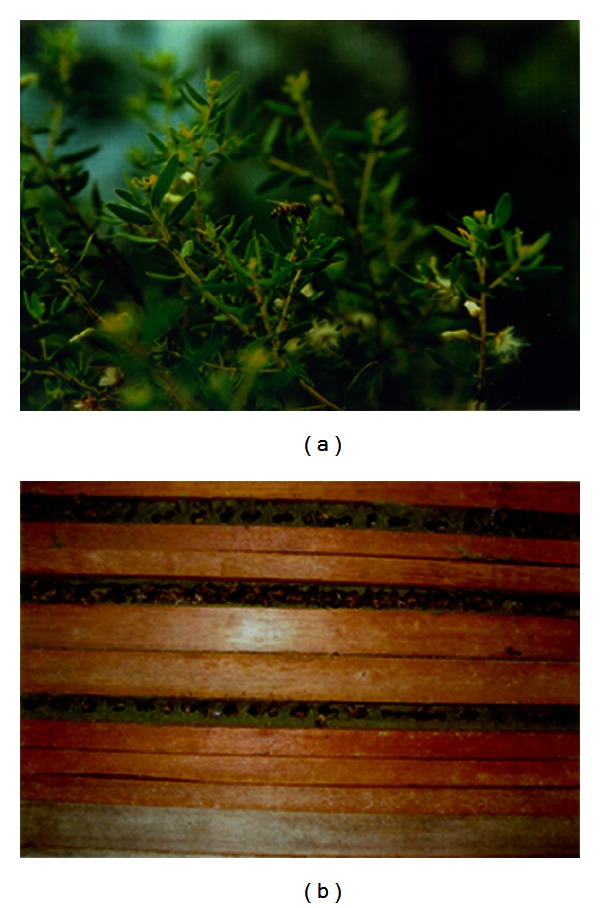
Apis mellifera collecting propolis of Baccharis dracunculifolia to production propolis in Brazil. (a) Apis mellifera collecting leaf apices Baccharis dracunculifolia; (b) deposition of green propolis cracks in the hive.
In early records are mentioned substances that cast doubt on the use or not of propolis. In Genesis (c. 1700 BC), tzori was taken to Egypt, once with honey and its healing properties are noted three times in Jeremiah. Twice, tzori came from Gilead, but it was not balm of Gilead which is produced from a tree, Commiphora opobalsamum. Assis believed that “black wax” referred to in the Egyptian Ebers papyrus (c. 1550 BC) may have been propolis. He also considered that Hebrew tzori was an early word for propolis. This occured six times in the Hebrew scriptures and was usually translated as balm or balsam [19].
Egyptians knew very well the antiputrefactive properties of propolis and used it to embalm cadavers. Greek and Roman physicians Aristoteles, Dioscorides, Pliny, and Galen were familiar with the medicinal properties of propolis. It is not known what methods were used for harvesting it in the ancient world, although writers in Greece and Rome were familiar with it. The Greek Historia Animalium referred to a substance mitys, which was probably propolis, as “a cure for bruises and suppurating sores.” According to Varro in Rome, propolis was used by physicians in making poultices, and for this reason it brings even a higher price than honey on the Via Sacra [19].
The propolis was employed as an antiseptic and cicatrizant in wound treatment and as a mouth disinfectant, with these uses being perpetuated in the Middle Ages and among Arab physicians. Propolis was also recognized by other peoples unrelated to the Old World civilizations: Incas employed propolis as an antipyretic agent, and the London pharmacopoeias of the seventeenth century listed propolis as an official drug. Between the seventeenth and twentieth centuries, the propolis became very popular in Europe on account of its antibacterial activity [18].
2.1. Publications and Patents
The first work indexed by Chemical Abstracts on propolis was in 1903, and the first patent was described in 1904 (USA—Composition for treating pins and piano strings). One hundred and nine years after the first publication in the Chemical Abstract, the number of publications on propolis reached 3,880 in journal and 2,884 in patents.
Figure 2 shows the number of publications on propolis over the decades; data were obtained by searching the Chemical Abstracts. The global interest in propolis research presents two justifications according to Pereira et al. [20], the first to present diverse biological properties and the second by high added value, the sale price of a bottle in Brazil is about 5 to 10 real.
Figure 2.
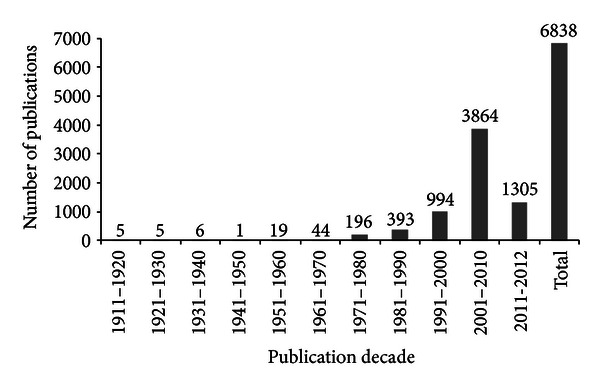
Scientific productivity on propolis between the decades (Chemical Abstracts).
The scientific production about propolis by document type is the majority about journal and patents as shown in Figure 3.
Figure 3.
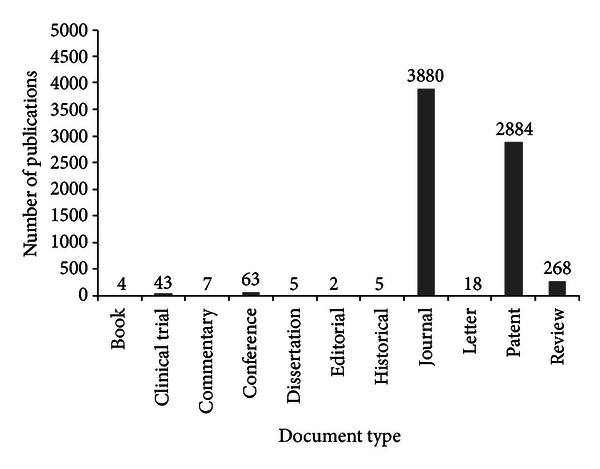
Scientific production on propolis by document type (Chemical Abstracts).
The processed patent documents contain highly valuable legal, economic, and technical information; hence, the results obtained from their processing make it possible to obtain highly valuable information to reach conclusions useful as key elements for the design of R&D, technological surveillance, market studies, and marketing strategies [21].
Since the first patent was filed and until today, it is possible to see that there was a considerable increase in the number of patents in the last thirty years (Figure 4).
Figure 4.
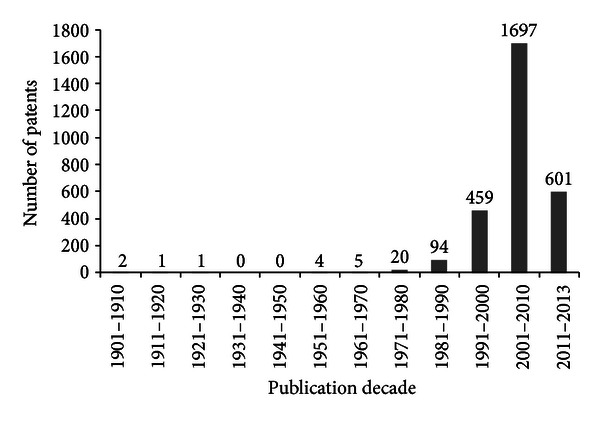
Scientific production on propolis by patents (Chemical Abstracts).
According to profile of patents, shown in Figure 5, China, Japan, and Russia are those that hold most of the patents. This fact can be justified by China and Russia being the largest producers of propolis. Today 42% of patents are Chinese (Figure 5), and the first Chinese patent appeared in 1993 (on “Process for production mouth freshener”). The Japanese have 15% of patents, and the first appeared in 1988 (about “Deodorants controlling mouth odor”). The first patent was obtained in 1968 on Russian “Toothpaste” and represented 12% of patents. Brazil deposited its first patent in 1997 on “Dental gel.” Some patents are presented in Table 1.
Figure 5.
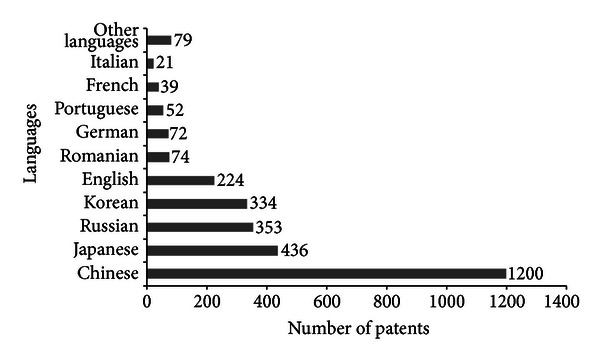
Scientific production on propolis by patents and languages (Chemical Abstracts).
Table 1.
Relationship of some of the 2,884 international patents (Chemical Abstracts).
| Year | Country | Title | Register |
|---|---|---|---|
| 1904 | USA | “Composition for treating piano pins and strings” | US767499 |
| 1920 | Unavailable | “Paint vehicles” | GB146986 |
| 1921 | USA | “Waterproof paint” | US1401261 |
| 1952 | Unavailable | “Tooth paste and oral disinfectant” | AT172063 |
| 1969 | USSR | “A dental elixir” | SU240182 |
| 1979 | Romania | “A powder containing soluble propolis” | RO67036 |
| 1990 | Japan | “Processed food containing propolis” | JP02154652 |
| 1995 | USA | “Treatment of acne/Pharmaceutical compositions for treatment of acne containing extracts of propolis, verbascum, etc” | US5399349 |
| 2009 | Turkey | “Use of propolis as base material under dental inlays and as filling material for root canals” | TR2009000486 |
| 2011 | Turkey | “Extract of propolis and Cramp Bark (Viburnum opulus) with high content of phenolic compounds useful as natural remedy” | TR2011000075 |
| 2012 | Korea | “Method for manufacturing functional food containing propolis” | KR2012136769 |
Suárez et al. [21] noted the trend of patent applications according to application area for the period 1972–2000 and observed a high incidence of products with medicinal and nutraceutical properties and with dermatological applications.
The scientific production on propolis and healthy patents between the decades in shown in Figure 6.
Figure 6.
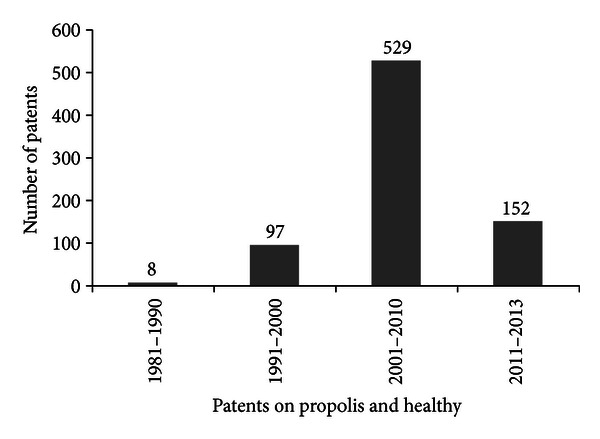
Scientific production on propolis and healthy by patents between the decades (Chemical Abstracts).
The inventions processed according to their priority country are which shown in Figure 7 in which the highest number of filings corresponds to China (476), followed by Japan (177), Korea and Russian with 77, and 29 and filings, respectively. Japan imports almost all the propolis used in the country: 80% comes from Brazil and 10% from China and other countries, and this is shown in their inventions, since in the analysis carried out to the content of the Japanese inventions we can see that the Brazilian propolis is the target of invention [21].
Figure 7.
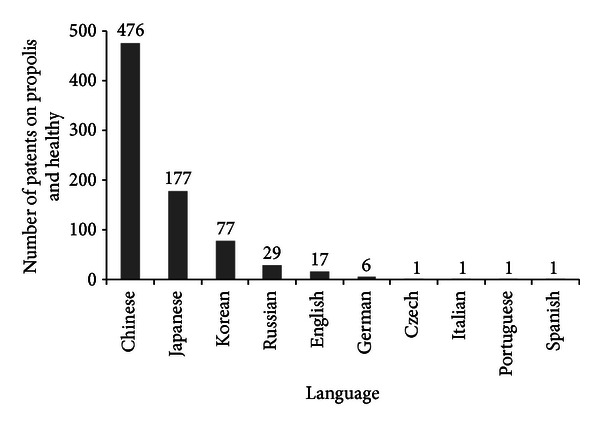
Scientific production on propolis and healthy by patents and languages (Chemical Abstracts).
Six percent of patents filed by 2012, refers to the use of propolis for dental treatment (Figure 8). According to Pereira et al. [20], this is one of the most widely studied applications of propolis worldwide.
Figure 8.
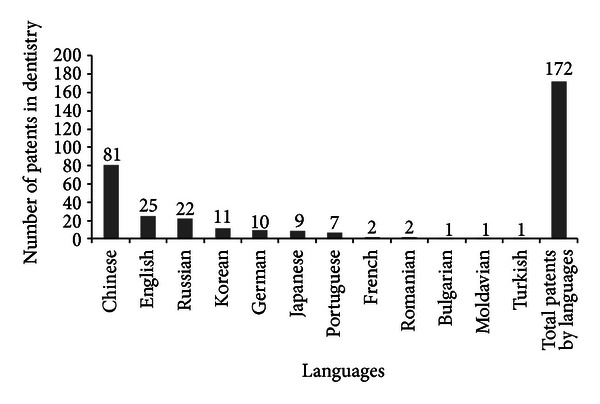
Scientific production on propolis for dental treatment by patents and languages (Chemical Abstracts).
According to the Ministry of Development Industry and Foreign Trade of Brazil [22], the Brazilian export market of propolis in the year of 2012 was 41,721 Kg corresponding about $5,401,643. These values can be observed in Table 2.
Table 2.
Brazilian propolis export market [49].
| Year | Quantity export (Kg) |
Value (U$S) |
Value per kilo (U$S/Kg) |
|---|---|---|---|
| 2010 | 51,213 | 4,346,604 | 84.87 |
| 2011 | 38,845 | 4,537,727 | 116.81 |
| 2012 | 41,721 | 5,401,643 | 129.47 |
Analyzing the data, it is possible to observe that there was a drop in sales in 2011 compared to 2010. Regarding the value of the product, there was an increase of over 50% in 2012 compared to 2010. According to Aga et al. [23], the country that buys Brazilian propolis is Japan, and its extensive use in foods and beverages intended to maintain or improve human health.
3. Chemical Composition and Propolis Activity
3.1. Chemical Composition
Propolis is a complex resinous mixture which contains approximately 50% of resin and balsam, 30% of wax, 10% of essential and aromatic oils, 5% of pollen, and 5% of impurities [24]. The chemical composition of propolis is highly variable mainly due to the variability of plant species growing around the hive, from which the bees collect the exudates [18, 25–28]. Additionally, propolis composition can vary depending on the seasonality, illumination, altitude, collector type, and food availability and activity developed during propolis exploitation [29–33].
Much work has been conducted on the chemical composition and biological activities. Until now, more than 300 chemical constituents have been identified in propolis from different regions [34]. The main chemical classes present in propolis are flavonoids, phenolics, and aromatic compounds (Figure 9) [35, 36]. Propolis also contains some volatile oils, terpenes, and bee wax, but these compounds are not believed to contribute as significantly to the chemical properties and effects of propolis [36].
Figure 9.
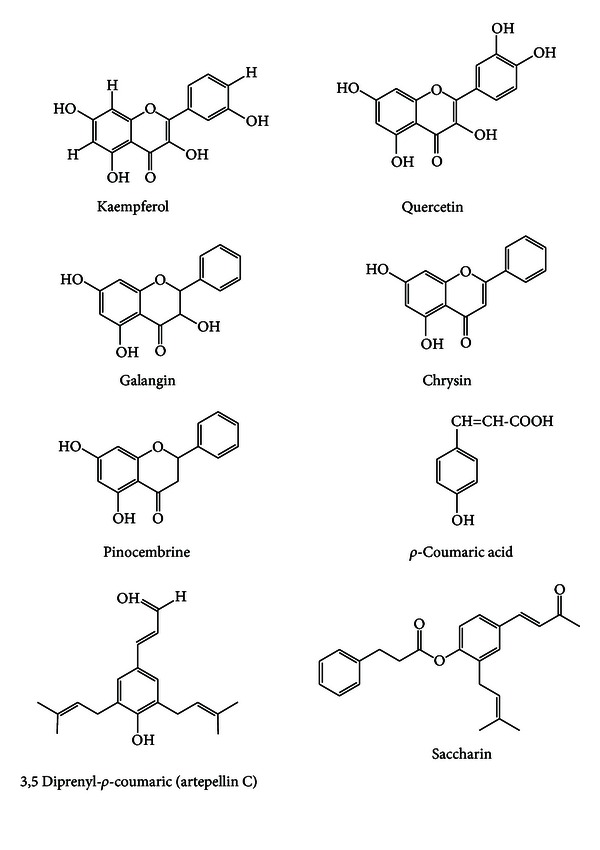
Some typical flavonoids and phenolics present in green propolis.
Many analytical methods have been used for separation and identification of propolis constituents. Differents compounds have been identified in ethanol extracts of propolis (Table 3).
Table 3.
Identified compounds in ethanol extracts of propolis.
| Sample | Compounds identified | Reference |
|---|---|---|
| Bulgarian propolis | 3,7-Dihydroxy-5-methoxyflavanone 2,5-dihydroxy-7-methoxyflavanone | [50] |
|
| ||
| North and South Bulgaria | Dihydrocaffeic acid Dihydroferulic acid Dihydroxyacetophenone hydroxymethoxyacetophenone β-Phenethyl alcohol Benzyl alcohol pinobanksin Pinostrobin Dimethyl kaempferol |
[51] |
|
| ||
| Brazil/São Paulo state | 3-Prenyl-4-dihydrocinnamoloxynnamic acid | [23] |
|
| ||
| Brazil/São Paulo state/Botucatu city | 9-E and 9-Z 2,2-Dimethyl-6-carboxyethenyl-8-prenyl-2H-benzopyran | [52] |
|
| ||
| Brazil/São Paulo state | Dehydroabietic acid Abietic acid β-Amyrine Triterpenic alcohol of amyrine Lanosterol isomer with 9(11) double bond |
[53] |
|
| ||
| Not reported | (E)-2,3-Dihydroconiferyl p-coumarate (E)-3-{2,3-Dihydro-2-[2-[(E)-pcoumaroyloxy]-1-methylethyl]-5-benzofuranyl}-2-propenoic acid (E)-4-(2,3-Dihydrocinnamoyloxy) cinnamic acid (E)-3-(2,2-Dimethyl-3,4-dihydro-3-hydroxy-2H-1-benzopyran-6-yl)-2-propenoic acid (E)-3-[2,3-Dihydro-2-(1-methylethenyl)-5-benzofuranyl]-2-propenoic acid (E)-3-[2,3-Dihydro-2-(1-methylethenyl)-7-prenyl-5-benzofuranyl]-2-propenoic acid (E)-3-{3-[(E)-4-(2,3-Dihydrocinnamoyloxy)-3-methyl-2-butenyl]-4-hydroxy-5-prenylphenyl}-2-propenoic acid Dihydrokaempferol (aromadendrin) 6-Methoxykaempferol 4-Hydroxy-3-prenylbenzoic acid Plicatin B Capillartemisin A |
[54] |
|
| ||
| Japan/Okinawa | Prokinawan | [55] |
|
| ||
| Brazilian propolis type 6 | Hyperibone A | [56] |
|
| ||
| Mexico/Champoton | 1-(3′,4′-Dihydroxy-2′-methoxyphenyl)-3-(phenyl)propane (z)-1-(2′-Methoxy-4′,5′-dihydroxyphenyl)-2-(3-phenyl)propene 3-Hydroxy-5,6-dimethoxyflavan (−)-7-Hidroxyflavanone (−)-Mucronulatol (−)-Arizonicanol a (+)-Vestitol (−)-Melilotocarpan a (−)-Melilotocarpan d (+)-Pinocembrin |
[57] |
|
| ||
| Greece (six regions) | 18-Hydroxyabieta-8, 11,13-triene Dihydroxyabieta-8,11,13-triene; hydroxydehydroabietic acid 18-Succinyloxyabietadiene 18-Succinyloxyabietadiene (isomer) 18-Succinyloxyhydroxyabietatriene |
[58] |
|
| ||
| Kenyan propolis | Tetrahydrojusticidin B 6-Methoxydiphyllin Phyllamyricin C Macarangin Schweinfurthin A Schweinfurthin B |
[59] |
|
| ||
| Indonesia/East Java province/Batu city | 5-Pentadecylresorcinol 5-(8′z, 11′z Heptadecadienyl)-resorcional 5-(11′z-Heptadecenyl)-resorcinol 5-Heptadecylresorcional Propolin d Propolin c Propolin f Propolin g |
[60] |
|
| ||
| Jordanian propolis | 24(z)-1β-3β-Dihydroxyeupha-7,24-dien-26-oic acid | [61] |
|
| ||
| Honduras | (E, Z)-Cinnamyl cinnamate | [62] |
|
| ||
| Solomon island | Solophenol (A) | [63] |
3.2. Method of Extraction
The method of extraction and solvent can change the chemical composition of propolis extract. Commercial products such as tablets, capsules, ampoules, and syrups are prepared with ethanolic extract of propolis. Methanol is only used for research purposes. Some varieties of propolis have solubility in water, thereby extracting water should also be considered for study [35].
3.3. Origin Botanical
The materials available to bees for production of propolis are substances actively secreted by plants as well as substances exuded from wounds in plants: lipophilic materials on leaves and leaf buds, resins, mucilages, gums, lattices, and so forth [37].
The composition of the plant source determines the chemical composition of bee glue, and it is dependent on its geographical location; as a result, its biological activity is closely related to the vegetation native to the site of collection [14, 38, 39].
Bankova [38] discusses the diversity of the chemical composition of propolis and the problem of standardization. The issue is based on the chemical composition of propolis which varies with the plant source collection. Dealing with reliable criteria for chemical standardization of different propolis types is needed, but such generally accepted criteria do not yet exist. There is still a lot of work to be done to achieve standardization of other propolis types. Working with standardization material will allow scientists to connect a particular chemical propolis type to a specific type of biological activity and formulate recommendations. Table 4 illustrates propolis of different geographic regions and their principal plant sources of chemical compounds.
Table 4.
Propolis of different geographic regions and their principal plants' sources of chemical compounds (from Bankova, 2005).
| Geographic origin | Plant source | References |
|---|---|---|
| Bulgaria | Populus nigra, P. italic | [16, 50, 63] |
| Albania | Populus nigra | [63] |
| Bulgaria | Populus tremula | [16] |
| Mongolia | Populus suaveolens | [16, 63] |
| USA (mainland) | Populus fremontii | [16] |
| USA (Hawaiian islands) | Plumeria acuminate, Plumeria acutifolia | [16] |
| United Kingdom | Populus euramericana | [16] |
| Hungary | Betula, Populus, Pinus, Prunus, and Acacia spp.; Aesculus hypocastane | [16] |
| Poland | Betula, Alnus spp. | [16] |
| Equatorial regions | Delchampia spp. | [16] |
| Equatorial regions | Clusia spp. | [16, 64] |
| Australia | Xanthorrhoea | [2] |
| North temperate zone | Poplar, birch, elm, alder, beech, conifer, and horse chestnut | [2] |
| Europe, North America, nontropic regions of Asia (poplar propolis) | Populus spp. of section Aigeiros, most often P. nigra L. | [1, 34, 65] |
| Russia (birch propolis) | Betula verrucosa Ehrh. | [66] |
| Brazil (green-alecrim-propolis) | Baccharis spp. Predominantly B. dracunculifolia DC. | [14, 67] |
| Cuba, Venezuela | Clusia minor | [16, 68–70] |
| Clusia spp. | ||
| South Brazil (type 3), Argentine, and Uruguay | Populus alba | [71] |
| Brazil (type 6 from northeastern Brazil) | Hyptis divaricate | [14] |
| Brazil (type 13 from northeastern Brazil) | Dalbergia ecastaphyllum | [17, 42] |
3.4. Classification of Brazilian Propolis
It was found that propolis from several regions of Brazil show different chemical composition, depending on the local flora at the site of collection [40]. The propolis from Brazil was classified in types according to its geographical origin, chemical composition, and source plant as shown in Table 5 [17, 41, 42]. More studies should be done in order to standardize propolis.
Table 5.
Classification of Brazilian propolis, according to their physicochemical characteristics and location [17, 41].
| Groups | Ethanolic extract of propolis | |
|---|---|---|
| Color | Origin of propolis | |
| Group 1 (RS5) | Yellow | Southern |
| Group 2 (RS1) | Brown | Southern |
| Group 3 (PR7) | Dark brown | Southern |
| Group 4 (PR8) | Brown | Southern |
| Group 5 (PR9) | Greenish brown | Southern |
| Group 6 (BA11) | Reddish brown | Northeast |
| Group 7 (BA51) | Greenish brown | Northeast |
| Group 8 (PE5) | Dark brown | Northeast |
| Group 9 (PE3) | Yellow | Northeast |
| Group 10 (CE3) | Dark yellow | Northeast |
| Group 11 (PI11) | Yellow | Northeast |
| Group 12 (SP12) | Green or greenish brown | Southeast |
| Group 13 (AL) | Red | Northeast |
3.5. Activity of Propolis
It is important to note that most of the latest investigations on new propolis constituents are connected to their biological activity. This information is summarized in Table 6. Some compounds from propolis have antibacterial activity, antitumor activity, and antiinflammatory activity, antioxidative and hepatoprotective action.
Table 6.
Chemical constituents of propolis that possess known pharmacological activities.
| Chemical compounds | Activities | References |
|---|---|---|
| Acacetin | Anti-inflammatory | [72] |
| Apigenin | Anti-inflammatory | [72] |
| Artepillin C | Antimicrobial Antitumor activity Antioxidative |
[23, 41, 73–75] |
| Caffeic acid phenethyl ester | Antitumor activity Anti-inflammatory |
[76, 77] |
| Chrysin | Anti-inflammatory | [72] |
| Caffeic acid | Antibacterial Antifungal Antiviral Anti-inflammatory |
[72, 78–80] |
| Cinnamic acid | Anti-inflammatory | [72] |
| Dicaffeoylquinic acid derivatives | Hepatoprotective | [81] |
| Ferulic acid | Anti-inflammatory | [72] |
| Galangin | Anti-inflammatory | [72] |
| Gallic acid | Anti-inflammatory | [72] |
| Moronic acid | Anti-HIV | [9] |
| Isoferulic acid | Anti-inflammatory | [72] |
| Pinostrobin | Local anesthesia | [82] |
| Protocatechuic acid | Anti-inflammatory | [72] |
| Pinocembrin | Antibacterial Antifungal Antimold Local anesthesia |
[79, 80, 82, 83] |
| Propofol | Antioxidative | [7] |
| ρ-Coumaric acid | Antibacterial | [74] |
| m-Coumaric acid | Anti-inflammatory | [72] |
| o-Coumaric acid | Anti-inflammatory | [72] |
| Quercetin | Anti-inflammatory Antiviral Antihistamine Ulcer healing Capillary strengthening |
[41, 78] |
| Volatile constituents (phenols, esters, terpenoids, etc.) |
Antibacterial | [64] |
| 2,2-Dimethyl-6-carboxyethyl-2H-1-benzopyran | Antimicrobial | [81] |
| 3-[3,4-Dihydroxy-5-prenylphenyl]-2-(E)-propenoic acid | Antioxidative | [84] |
According to Bankova et al. [34], relating the chemical constituents of propolis with biological activity enables the standardization of the application of propolis. Kumazawa et. al. [28] report that differences in the chemical composition of propolis from different sources change the spectrum of biological activity of propolis.
Some studies have been conducted correlating chemical composition and biological activity, but no tested compounds were isolated [43–47].
4. Application in Medicine and Dentistry
Propolis has been found to have a wide spectrum of biological and pharmaceutical properties and has been demonstrated to have direct antimicrobial effects in vitro [48]. Some recent studies suggested that propolis can be used in medicine and dentistry. Tables 7 and 8 illustrate some studies that show the application of propolis in medicine and dentistry.
Table 7.
Recent studies on application of propolis in medicine.
| Application in medicine | |||
|---|---|---|---|
| Geographic origin of propolis | Activity attributed | Test performed | References |
| Brazil (southern) | Anti-HIV activity | In vitro (H9 Lymphocytes) | [9] |
| Brazil | Anticancer activity | In vivo—mice (pulmonary tumors) | [85] |
| Brazil | Anticancer activity | In vitro (human tumor cell lines) | [86] |
| Brazil (group 3 and group 12) | Suppression of dioxin | In vitro | [87] |
| Chile | Antioxidant and anticancer |
In vitro
(KB cells—human mouth epidermoid carcinoma cells; Caco-2 cells—human colon adenocarcinoma cells) |
[88] |
| Brazil | Anticancer activity | In vitro and in vivo (retinal damage) | [89] |
| Brazil (group 3, group 12, and bud resins of botanical origin) | Anticancer activity | In vitro (human prostate epithelial cells) | [90] |
| Brazil | Antiinfluenza virus activity | In vivo-mice (influenza virus) | [91] |
| Jordanian | Antibacterial | In vitro | [92] |
| Tunisia | Anticancer activity | In vitro (cancer cell lines—HT29, A549, Hep-2, raw264.7, and Vero) | [93] |
| Brazil (group 12 and artepellin C) | Immunosuppressant | In vitro (CD4 T cell) | [94] |
| Portugal | Anticancer activity | In vitro (human renal cancer) | [95] |
| Israel (Kibbutz Yad Mordecai and CAPE) | Anticancer activity | In vitro (human T-cell lines) | [96] |
| Brazil | Anticancer activity | In vitro (human breast cancer MCF-7 cells) | [97] |
| Brazil (group 12 and group 13) | Anticancer activity | In vitro (human cell lins of leukemia) | [98] |
| CAPE (derived from honeybee hive propolis) | Anticancer activity | In vitro (human prostate cancer cells) | [99] |
| Brazil | Anticancer activity | In vivo—mice (skin carcinogenesis) | [100] |
| Poland | Anticancer activity | In vitro (U87MG human glioblastoma) | [101] |
Table 8.
Recent studies on application of propolis in dentistry.
| Application in dentistry | |||
|---|---|---|---|
| Geographic origin of propolis | Activity attributed | Test performed | References |
| Japan | Inhibited glucosyltransferase activity | In vivo—rats | [102] |
| Brazil (extracts of propolis from the states of Minas Gerais, São Paulo, Goiás, Mato Grosso do Sul, Paraná, and Rio Grande do Sul) | Inhibited glucosyltransferase activity | In vitro | [8] |
| Brazil (extracts of propolis from the states of Minas Gerais and Rio Grande do Sul) | Cariostatic effect | In vivo—rats | [103] |
| Brazil (extracts of propolis from the states of Minas Gerais and Rio Grande do Sul) | Inhibited glucosyltransferase activity | In vitro | [104] |
| Brazil (Minas Gerais state) | Antibacterial activity Inhibition of cell adherence Inhibition of water-insoluble glucan formation |
In vitro | [105] |
| Brazil (extracts of propolis from the states of Minas Gerais and Rio Grande do Sul) | Cariostatic effect | Human | [106] |
| Brazil (extract of propolis from Bahia state) | Exceptionally effective against Streptococcus mutans | In vitro | [107] |
| Apigenin and tt-farnesol | Glucosyltransferase activity | In vivo—rats | [108] |
| Apigenin and tt-farnesol (association) | Cariostatic effect | In vitro | [109] |
| Brazil (Isolated fractions) | Cariostatic effect | In vitro and in vivo | [110] |
| Brazil (Bahia state) | Cariostatic effect | In vivo—rats | [111] |
| Brazil (extracts of propolis) | Cariostatic effect | Human | [112] |
| Tunisia | Cariogenic activity Inhibition oral biofilm formation |
In vitro | [93] |
| Korea | Antibacterial activity | In vitro | [113] |
5. Conclusions
Propolis has been used extensively as a folk medicine because of its special chemical components, strong pharmacological, properties and low toxicity. This wide spectrum of therapeutic effects makes propolis a potential candidate in several clinical scenarios. Clinical studies are now also in progress to verify the effects of propolis in the prevention and treatment of diseases.
The application of propolis is mostly in the drug or food manufacture in the form of mixtures. Current opinion is that the use of standardized preparations of propolis is safe and less toxic than many synthetic medicines, but the components of propolis are variable, and it is difficult to standardize and apply propolis. Robust manufacturing processes, standardized quality controls, and good design clinical trials are all critical steps in verifying these claims.
References
- 1.Greenaway W, Scaysbrook T, Whately FR. The composition and plant origin of propolis: a report of work Oxford. Bee World. 1990;71(3):107–118. [Google Scholar]
- 2.Ghisalberti EL. Propolis: a review. Bee World. 1979;60(2):59–84. [Google Scholar]
- 3.Matsuno T, Matsumoto Y, Saito M, Morikawa J. Isolation and characterization of cytotoxic diterpenoid isomers from propolis. Zeitschrift für Naturforschung C. 1997;52(9-10):702–704. doi: 10.1515/znc-1997-9-1020. [DOI] [PubMed] [Google Scholar]
- 4.Vynograd N, Vynograd I, Sosnowski Z. A comparative multi-centre study of the efficacy of propolis, acyclovir and placebo in the treatment of genital herpes (HSV) Phytomedicine. 2000;7(1):1–6. doi: 10.1016/S0944-7113(00)80014-8. [DOI] [PubMed] [Google Scholar]
- 5.Kimoto T, Aga M, Hino K, et al. Apoptosis of human leukemia cells induced by Artepillin C, an active ingredient of Brazilian propolis. Anticancer Research. 2001;21(1 A):221–228. [PubMed] [Google Scholar]
- 6.Kimoto T, Arai S, Kohguchi M, et al. Apoptosis and suppression of tumor growth by Artepillin C extracted from Brazilian propolis. Cancer Detection and Prevention. 1998;22(6):506–515. doi: 10.1046/j.1525-1500.1998.00020.x. [DOI] [PubMed] [Google Scholar]
- 7.Basnet P, Matsuno T, Neidlein R. Potent free radical scavenging activity of propol isolated from Brazilian propolis. Zeitschrift für Naturforschung C. 1997;52(11-12):828–833. doi: 10.1515/znc-1997-11-1217. [DOI] [PubMed] [Google Scholar]
- 8.Park YK, Koo MH, Abreu JAS, Ikegaki M, Cury JA, Rosalen PL. Antimicrobial activity of propolis on oral microorganisms. Current Microbiology. 1998;36(1):24–28. doi: 10.1007/s002849900274. [DOI] [PubMed] [Google Scholar]
- 9.Ito J, Chang FR, Wang HK, et al. Anti-AIDS agents. 48. Anti-HIV activity of moronic acid derivatives and the new melliferone-related triterpenoid isolated from Brazilian propolis. Journal of Natural Products. 2001;64(10):1278–1281. doi: 10.1021/np010211x. [DOI] [PubMed] [Google Scholar]
- 10.Burdock GA. Review of the biological properties and toxicity of bee propolis (propolis) Food and Chemical Toxicology. 1998;36(4):347–363. doi: 10.1016/s0278-6915(97)00145-2. [DOI] [PubMed] [Google Scholar]
- 11.Bankova V, Marekov N. Propolis-chemical composition and standardization. Farmatsiya. 1984;32:8–18. [Google Scholar]
- 12.Garcia-Vigueira C, Greenaway W, Whatley F. Composition of propolis from two different Spanish regions. Zeitschrift für Naturforschung C. 1992;47:634–637. [Google Scholar]
- 13.Konig B. Plant sources of propolis. Bee World. 1985;66(4):136–139. [Google Scholar]
- 14.Park YK, Alencar SM, Aguiar CL. Botanical origin and chemical composition of Brazilian propolis. Journal of Agricultural and Food Chemistry. 2002;50(9):2502–2506. doi: 10.1021/jf011432b. [DOI] [PubMed] [Google Scholar]
- 15.Park YK, Paredes-Guzman JF, Aguiar CL, Alencar SM, Fujiwara FY. Chemical constituents in Baccharis dracunculifolia as the main botanical origin of Southeastern Brazilian propolis. Journal of Agricultural and Food Chemistry. 2004;52(5):1100–1103. doi: 10.1021/jf021060m. [DOI] [PubMed] [Google Scholar]
- 16.Marcucci MC. Propolis: chemical composition, biological properties and therapeutic activity. Apidologie. 1995;26(2):83–99. [Google Scholar]
- 17.Daugsch A, Moraes CS, Fort P, Park YK. Brazilian red propolis—chemical composition and botanical origin. Evidence-Based Complementary and Alternative Medicine. 2008;5(4):435–441. doi: 10.1093/ecam/nem057. [DOI] [PMC free article] [PubMed] [Google Scholar]
- 18.Castaldo S, Capasso F. Propolis, an old remedy used in modern medicine. Fitoterapia. 2002;73(supplement 1):S1–S6. doi: 10.1016/s0367-326x(02)00185-5. [DOI] [PubMed] [Google Scholar]
- 19.Crane E. The past and present importance of bee products to man. In: Mizrahi A, Lensky Y, editors. Bee Products—Properties, Applications, and Apitherapy. New York, NY, USA: Plenum Press; 1997. pp. 1–13. [Google Scholar]
- 20.Pereira AS, Seixas FRMS, Aquino Neto FR. Própolis: 100 anos de pesquisa e suas perspectivas futuras. Química Nova. 2002;25(2):321–326. [Google Scholar]
- 21.Suárez D, Zayas D, Guisado F. Propolis: patents and technology trends for health applications. Journal of Business Chemistry. 2005;2(3):119–125. [Google Scholar]
- 22.Ministério do desenvolvimento da indústria e comércio. http://aliceweb.mdic.gov.br.
- 23.Aga H, Shibuya T, Sugimoto T, Kurimoto M, Nakajima S. Isolation and identification of antimicrobial compounds in Brazilian propolis. Bioscience, Biotechnology and Biochemistry. 1994;58(5):945–946. [Google Scholar]
- 24.Thomson W. Propolis. Medical Journal of Australia. 1990;153(article 654) doi: 10.5694/j.1326-5377.1990.tb126313.x. [DOI] [PubMed] [Google Scholar]
- 25.Markham KR, Mitchell KA, Wilkins AL, Daldy JA, Lu Y. HPLC and GC-MS identification of the major organic constituents in New Zealand propolis. Phytochemistry. 1996;42(1):205–211. [Google Scholar]
- 26.Bankova V, Boudourova-Krasteva G, Sforcin JM, et al. Phytochemical evidence for the plant origin of Brazilian propolis from Sao Paulo state. Zeitschrift für Naturforschung C. 1999;54(5-6):401–405. doi: 10.1515/znc-1999-5-616. [DOI] [PubMed] [Google Scholar]
- 27.Kujumgiev A, Tsvetkova I, Serkedjieva Y, Bankova V, Christov R, Popov S. Antibacterial, antifungal and antiviral activity of propolis of different geographic origin. Journal of Ethnopharmacology. 1999;64(3):235–240. doi: 10.1016/s0378-8741(98)00131-7. [DOI] [PubMed] [Google Scholar]
- 28.Kumazawa S, Hamasaka T, Nakayama T. Antioxidant activity of propolis of various geographic origins. Food Chemistry. 2004;84(3):329–339. [Google Scholar]
- 29.Katircioğlu H, Mercan N. Antimicrobial activity and chemical compositions of Turkish propolis from different regions. African Journal of Biotechnology. 2006;5(11):1151–1153. [Google Scholar]
- 30.Bankova V, Boudourova-Krasteva G, Popov S, Sforcin JM, Funari SRC. Seasonal vatiations of the chemical composition of Brazilian propolis. Apidologie. 1998;29(4):361–367. [Google Scholar]
- 31.Sforcin JM, Novelli EL, Funari SRC. Seasonal effect of Brazilian propolis on seric biochemical variables. Journal of Venomous Animals and Toxins Including Tropical Diseases. 2000;8:244–254. [Google Scholar]
- 32.Silici S, Kutluca S. Chemical composition and antibacterial activity of propolis collected by three different races of honeybees in the same region. Journal of Ethnopharmacology. 2005;99(1):69–73. doi: 10.1016/j.jep.2005.01.046. [DOI] [PubMed] [Google Scholar]
- 33.Castro ML, Cury JA, Rosalen PL, et al. Própolis do sudeste e nordeste do Brasil: influência da sazonalidade na atividade antibacteriana e composição fenólica. Química Nova. 2007;30:1512–1521. [Google Scholar]
- 34.Bankova VS, de Castro SL, Marcucci MC. Propolis: recent advances in chemistry and plant origin. Apidologie. 2000;31(1):3–15. [Google Scholar]
- 35.Xu Y, Luo L, Chen B, Fu Y. Recent development of chemical components in propolis. Frontiers of Biology in China. 2009;4(4):385–391. [Google Scholar]
- 36.Schmidt JO. Chemical composition and application. In: Mizrahi A, Lensky Y, editors. Bee Products—Properties, Applications, and Apitherapy. New York, NY, USA: New York; 1997. pp. 15–26. [Google Scholar]
- 37.Crane E. Beekeping: Science, Practice and World Resources. London, UK: Butterworth Heinemann; 1988. [Google Scholar]
- 38.Bankova V. Chemical diversity of propolis and the problem of standardization. Journal of Ethnopharmacology. 2005;100(1-2):114–117. doi: 10.1016/j.jep.2005.05.004. [DOI] [PubMed] [Google Scholar]
- 39.Christov R, Trusheva B, Popova M, Bankova V, Bertrand M. Chemical composition of propolis from Canada, its antiradical activity and plant origin. Natural Product Research. 2005;19(7):673–678. doi: 10.1080/14786410512331328159. [DOI] [PubMed] [Google Scholar]
- 40.Trusheva B, Popova M, Bankova V, et al. Bioactive constituents of Brazilian red propolis. Evidence-Based Complementary and Alternative Medicine. 2006;3(2):249–254. doi: 10.1093/ecam/nel006. [DOI] [PMC free article] [PubMed] [Google Scholar]
- 41.Park YK, Ikegaki M, Alencar SM, Moura FF. Evaluation of Brazilian propolis by both physicochemical methods and biological activity. Honeybee Science. 2000;21(2):85–90. [Google Scholar]
- 42.Alencar SM, Oldoni TLC, Castro ML, et al. Chemical composition and biological activity of a new type of Brazilian propolis: red propolis. Journal of Ethnopharmacology. 2007;113(2):278–283. doi: 10.1016/j.jep.2007.06.005. [DOI] [PubMed] [Google Scholar]
- 43.da Silva JFM, de Souza MC, Matta SR, de Andrade MR, Vidal FVN. Correlation analysis between phenolic levels of Brazilian propolis extracts and their antimicrobial and antioxidant activities. Food Chemistry. 2006;99(3):431–435. [Google Scholar]
- 44.Salomão K, Pereira PRS, Campos LC, et al. Brazilian propolis: correlation between chemical composition and antimicrobial activity. Evidence-Based Complementary and Alternative Medicine. 2008;5(3):317–324. doi: 10.1093/ecam/nem058. [DOI] [PMC free article] [PubMed] [Google Scholar]
- 45.Cabral ISR, Oldoni TLC, Prado A, Bezerra RMN, Alencar SM. Composição fenólica, atividade antibacteriana e antioxidante da própolis vermelha brasileira. Química Nova. 2009;32(6):1523–1527. [Google Scholar]
- 46.Gregoris E, Stevanato R. Correlations between polyphenolic composition and antioxidant activity of Venetian propolis. Food and Chemical Toxicology. 2010;48(1):76–82. doi: 10.1016/j.fct.2009.09.018. [DOI] [PubMed] [Google Scholar]
- 47.Righi AA, Alves TR, Negri G, Marques LM, Breyer H, Salatino A. Brazilian red propolis: unreported substances, antioxidant and antimicrobial activities. Journal of the Science of Food and Agriculture. 2011;91:2363–2370. doi: 10.1002/jsfa.4468. [DOI] [PubMed] [Google Scholar]
- 48.Ugur A, Arslan T. An in vitro study on antimicrobial activity of propolis from Mugla Province of Turkey. Journal of Medicinal Food. 2004;7(1):90–94. doi: 10.1089/109662004322984761. [DOI] [PubMed] [Google Scholar]
- 49.Paviani LC, Dariva C, Marcucci MC, Cabral FA. Supercritical carbon dioxide selectivity to fractionate phenolic compounds from the dry ethanolic extract of propolis. Journal of Food Process Engineering. 2010;33(1):15–27. [Google Scholar]
- 50.Bankova VS, Popov SS, Marekov NL. A study on flavonoids of propolis. Journal of Natural Products. 1983;46(4):471–474. [Google Scholar]
- 51.Bankova V, Dyulgerov A, Popov S, Marekov N. A GC/MS study of the propolis phenolic constituents. Zeitschrift für Naturforschung C. 1987;42:147–151. [Google Scholar]
- 52.Boudourova-Krasteva G, Bankova V, Sforcin JM, Nikolova N, Popov S. Phenolics from Brazilian propolis. Zeitschrift für Naturforschung C. 1997;52(9-10):676–679. [Google Scholar]
- 53.Marcucci MC, Rodriguez J, Ferreres F, Bankova V. Chemical composition of Brazilian propolis from Sao Paulo state. Zeitschrift für Naturforschung C. 1998;53(1-2):117–119. [Google Scholar]
- 54.Tazawa S, Warashina T, Noro T. Studies on the constituents of Brazilian propolis. II. Chemical and Pharmaceutical Bulletin. 1999;47(10):1388–1392. [Google Scholar]
- 55.Kumazawa S, Ueda R, Hamasaka T, Fukumoto S, Fujimoto T, Nakayama T. Antioxidant prenylated flavonoids from propolis collected in Okinawa, Japan. Journal of Agricultural and Food Chemistry. 2007;55(19):7722–7725. doi: 10.1021/jf071187h. [DOI] [PubMed] [Google Scholar]
- 56.Castro ML, Nascimento AMD, Ikegaki M, Costa-Neto CM, Alencar SM, Rosalen PL. Identification of a bioactive compound isolated from Brazilian propolis type 6. Bioorganic and Medicinal Chemistry. 2009;17(14):5332–5335. doi: 10.1016/j.bmc.2009.04.066. [DOI] [PubMed] [Google Scholar]
- 57.Lotti C, Fernandez MC, Piccinelli AL, Cuesta-Rubio O, Hernández IM, Rastrelli L. Chemical constituents of red Mexican propolis. Journal of Agricultural and Food Chemistry. 2010;58(4):2209–2213. doi: 10.1021/jf100070w. [DOI] [PubMed] [Google Scholar]
- 58.Popova MP, Graikou K, Chinou I, Bankova VS. GC-MS profiling of diterpene compounds in Mediterranean propolis from Greece. Journal of Agricultural and Food Chemistry. 2010;58(5):3167–3176. doi: 10.1021/jf903841k. [DOI] [PubMed] [Google Scholar]
- 59.Petrova A, Popova M, Kuzmanova C, et al. New biologically active compounds from Kenyan propolis. Fitoterapia. 2010;81(6):509–514. doi: 10.1016/j.fitote.2010.01.007. [DOI] [PubMed] [Google Scholar]
- 60.Trusheva B, Popova M, Koendhori EB, Tsvetkova I, Naydenski C, Bankova V. Indonesian propolis: chemical composition, biological activity and botanical origin. Natural Product Research. 2011;25(6):606–613. doi: 10.1080/14786419.2010.488235. [DOI] [PubMed] [Google Scholar]
- 61.Shaheen SA, Zarga MH, Nazer IK, Darwish RM, Al-Jaber HI. Chemical constituents of Jordanian propolis. Natural Product Research. 2011;25(14):1312–1318. doi: 10.1080/14786419.2010.509060. [DOI] [PubMed] [Google Scholar]
- 62.Lotti C, Piccineli AL, Arevalo C, et al. Constituents of Hondurian propolis with inhibitory effects on Saccharomyces cerevisiae multidrug resistance protein Pdr5p. Journal of Agricultural and Food Chemistry. 2012;60(42):10540–10545. doi: 10.1021/jf302578r. [DOI] [PubMed] [Google Scholar]
- 63.Bankova V, Christov R, Popov S, Pureb O, Bocari G. Volatile constituents of propolis. Zeitschrift für Naturforschung C. 1994;49:6–10. [Google Scholar]
- 64.Bankova V, Christov R, Kujumgiev A, Marcucci MC, Popov S. Chemical composition and antibacterial activity of Brazilian propolis. Zeitschrift für Naturforschung C. 1995;50(3-4):167–172. doi: 10.1515/znc-1995-3-402. [DOI] [PubMed] [Google Scholar]
- 65.Nagy E, Papay V, Litkei G, Dinya Z. Investigation of the chemical constituents, particularly the flavonoid components, of propolis and Populi gemma by GC/MS method. Studies in Organic Chemistry. 1986;23:223–232. [Google Scholar]
- 66.Popravko SA, Sokolov MV. Plant sources of propolis. Pchelovodstvo. 1980;2:28–29. (Rus). [Google Scholar]
- 67.Marcucci MC, Bankova VS. Chemical composition, plant origin and biological activity of Brazilian propolis. Current Topics in Phytochemistry. 1999;2:115–123. [Google Scholar]
- 68.Tomás-Barberán FA, García-Vigueira C, Vit-Olivier P, Ferreres F, Tomás-Lorente F. Phytochemical evidence for the botanical origin f tropical propolis from Venezuela. Phytochemistry. 1993;34(1):191–196. [Google Scholar]
- 69.Cuesta-Rubio O, Frontana-Uribe BA, Ramírez-Apan T, Cárdenas J. Polyisoprenylated benzophenones in Cuban propolis; biological activity of nemorosone. Zeitschrift für Naturforschung C. 2002;57(3-4):372–378. doi: 10.1515/znc-2002-3-429. [DOI] [PubMed] [Google Scholar]
- 70.Trusheva B, Popova M, Naydenski H, Tsvetkova I, Rodriguez JG, Bankova V. New polyisoprenylated benzophenones from Venezuelan propolis. Fitoterapia. 2004;75(7-8):683–689. doi: 10.1016/j.fitote.2004.08.001. [DOI] [PubMed] [Google Scholar]
- 71.Park YK, Alencar SM, Scamparini ARP, Aguiar CL. Própolis produzida no Sul do Brasil, Argentina e Uruguai: evidências fitoquímicas de sua origem vegetal. Ciência Rural. 2002;32(6):997–1003. [Google Scholar]
- 72.Banskota AH, Tezuka Y, Adnyana IK, et al. Hepatoprotective and anti-Helicobacter pylori activities of constituents from Brazilian propolis. Phytomedicine. 2001;8(1):16–23. doi: 10.1078/0944-7113-00004. [DOI] [PubMed] [Google Scholar]
- 73.Matsuno T, Matsumoto Y, Saito M, Mprikawa J. Antitumor benzopyran derivative of propolis. Chemical Abstracts. 1997;12639814j [Google Scholar]
- 74.Matsuno T, Saito M, Matsumoto Y, Morikawa J. A new benzo-γ-pyran derivative isolated from propolis. Zeitschrift für Naturforschung C. 1998;53(11-12):1037–1039. [Google Scholar]
- 75.Hashimoto T, Aga H, Tabuchi A, et al. Anti-Helicobacter pylori compounds in Brazilian propolis. Natural Medicines. 1998;52(6):518–520. [Google Scholar]
- 76.Grunberger D, Banerjee R, Eisinger K, et al. Preferential cytotoxicity on tumor cells by caffeic acid phenethyl ester isolated from propolis. Experientia. 1988;44(3):230–232. doi: 10.1007/BF01941717. [DOI] [PubMed] [Google Scholar]
- 77.Mirzoeva OK, Calder PC. The effect of propolis and its components on eicosanoid production during the inflammatory response. Prostaglandins Leukotrienes and Essential Fatty Acids. 1996;55(6):441–449. doi: 10.1016/s0952-3278(96)90129-5. [DOI] [PubMed] [Google Scholar]
- 78.Konig B, Dustmann JH. Fortschritte der celler untersuchungen zur antivirotischen aktivität von propolis. Apidologie. 1985;15:228–230. [Google Scholar]
- 79.Villanueva VR, Barbier M, Gonnet M, Lavie P. The flavonoids of propolis. Isolation of a new bacteriostatic substance: pinocembrin (dihydroxy-5, 7 flavanone) Annales de l'Institut Pasteur. 1970;118(1):84–87. [PubMed] [Google Scholar]
- 80.Metzner J, Schneidewind EM, Friedrich E. On the effects of propolis and pinocembrin on blastomyces. Pharmazie. 1977;32(11):p. 730. [PubMed] [Google Scholar]
- 81.Basnet P, Matsushige K, Hase K, Kadota S, Namba T. Four di-O-caffeoyl quinic acid derivatives from propolis. Potent hepatoprotective activity in experimental liver injury models. Biological and Pharmaceutical Bulletin. 1996;19(11):1479–1484. doi: 10.1248/bpb.19.1479. [DOI] [PubMed] [Google Scholar]
- 82.Paintz M, Metzner J. Zur iokalanästhetischen wirkung von propolis und einigen Inhaltsstoffen. Pharmazie. 1979;34:839–841. [Google Scholar]
- 83.Miyakado M, Kato T, Ohno N, Mabry TJ. Pinocembrin and (+)-β-eudesmol from Hymenoclea monogyra and Baccharis glutinosa . Phytochemistry. 1976;15(5):p. 846. [Google Scholar]
- 84.Hayashi K, Komura S, Isaji N, Ohishi N, Yagi K. Isolation of antioxidative compounds from Brazilian propolis: 3,4-dihydroxy-5-prenylcinnamic acid, a novel potent antioxidant. Chemical and Pharmaceutical Bulletin. 1999;47(11):1521–1524. [Google Scholar]
- 85.Kimoto T, Koya-Miyata S, Hino K, et al. Pulmonary carcinogenesis induced by ferric nitrilotriacetate in mice and protection from it by Brazilian propolis and artepillin C. Virchows Archiv. 2001;438(3):259–270. doi: 10.1007/s004280000350. [DOI] [PubMed] [Google Scholar]
- 86.Akao Y, Maruyama H, Matsumoto K, et al. Cell growth inhibitory effect of cinnamic acid derivatives from propolis on human tumor cell lines. Biological and Pharmaceutical Bulletin. 2003;26(7):1057–1059. doi: 10.1248/bpb.26.1057. [DOI] [PubMed] [Google Scholar]
- 87.Park YK, Fukuda I, Ashida H, et al. Suppression of dioxin mediated aryl hydrocarbon receptor transformation by ethanolic extracts of propolis. Bioscience, Biotechnology and Biochemistry. 2004;68(4):935–938. doi: 10.1271/bbb.68.935. [DOI] [PubMed] [Google Scholar]
- 88.Russo A, Cardile V, Sanchez F, Troncoso N, Vanella A, Garbarino JA. Chilean propolis: antioxidant activity and antiproliferative action in human tumor cell lines. Life Sciences. 2004;76(5):545–558. doi: 10.1016/j.lfs.2004.07.019. [DOI] [PubMed] [Google Scholar]
- 89.Inokuchi Y, Shimazawa M, Nakajima Y, Suemori S, Mishima S, Hara H. Brazilian green propolis protects against retinal damage in vitro and in vivo . Evidence-Based Complementary and Alternative Medicine. 2006;3(1):71–77. doi: 10.1093/ecam/nek005. [DOI] [PMC free article] [PubMed] [Google Scholar]
- 90.Li H, Kapur A, Yang JX, et al. Antiproliferation of human prostate cancer cells by ethanolic extracts of Brazilian propolis and its botanical origin. International Journal of Oncology. 2007;31(3):601–606. [PubMed] [Google Scholar]
- 91.Shimizu T, Hino A, Tsutsumi A, Yong KP, Watanabe W, Kurokawa M. Anti-influenza virus activity of propolis in vitro and its efficacy against influenza infection in mice. Antiviral Chemistry and Chemotherapy. 2008;19(1):7–13. doi: 10.1177/095632020801900102. [DOI] [PubMed] [Google Scholar]
- 92.Darwish RM, Fares RJA, Zarga MHA, Nazer IK. Antibacterial effect of Jordanian propolis and isolated flavonoids against human pathogenic bacteria. African Journal of Biotechnology. 2010;9(36):5966–5974. [Google Scholar]
- 93.Kouidhi B, Zmantar T, Bakhrouf A. Anti-cariogenic and anti-biofilms activity of Tunisian propolis extract and its potential protective effect against cancer cells proliferation. Anaerobe. 2010;16(6):566–571. doi: 10.1016/j.anaerobe.2010.09.005. [DOI] [PubMed] [Google Scholar]
- 94.Cheung KW, Sze DMY, Chan WK, Deng RX, Tu W, Chan GCF. Brazilian green propolis and its constituent, artepellin C inhibits allogenic activated human CD4 T cells expansion and activation. Journal of Ethnopharmacology. 2011;138(2):463–471. doi: 10.1016/j.jep.2011.09.031. [DOI] [PubMed] [Google Scholar]
- 95.Valente MJ, Baltazar AF, Henrique R, Estevinho L, Carvalho M. Biological activities of Portuguese propolis: protection against free radical-induced erythrocyte damage and inhibition of human renal cancer cell growth in vitro . Food and Chemical Toxicology. 2011;49(1):86–92. doi: 10.1016/j.fct.2010.10.001. [DOI] [PubMed] [Google Scholar]
- 96.Shvarzbeyn J, Huleihel M. Effect of propolis and caffeic acid phenethyl ester (CAPE) on NFκB activation by HTLV-1 Tax. Antiviral Research. 2011;90(3):108–115. doi: 10.1016/j.antiviral.2011.03.177. [DOI] [PubMed] [Google Scholar]
- 97.Kamiya T, Nishihara H, Hara H, Adachi T. Ethanol extract of Brazilian red propolis induces apoptosis in human breast cancer MCF-3 cells through endoplasmic reticulum stress. Journal of Agricultural and Food Chemistry. 2012;60(44):11065–11070. doi: 10.1021/jf303004n. [DOI] [PubMed] [Google Scholar]
- 98.Franchi GC, Jr., Moraes CS, Toreti VC, Daugsch A, Nowill AE, Park YK. Comparison of effects of the ethanolic extracts of Brazilian propolis on human leukemic cells as assessed with the MTT assay. Evidence-Based Complementary and Alternative Medicine. 2012;2012:6 pages. doi: 10.1155/2012/918956.918956 [DOI] [PMC free article] [PubMed] [Google Scholar]
- 99.Chuu CP, Lin HP, Ciacco MF, et al. Caffeic acid phenethyl ester suppresses the proliferation on human prostate cancer cells through inhibition of p70S6K and Akt signaling networks. Cancer Prevention Research. 2012;5(5):788–797. doi: 10.1158/1940-6207.CAPR-12-0004-T. [DOI] [PMC free article] [PubMed] [Google Scholar]
- 100.Yasukawa K, Yu SY, Tsutsumi S, Kurokawa M, Park YK. Inhibitory effects of Brazilian propolis on tumor promotion in two-stage mouse skin carcinogenesis. Journal of Pharmacy and Nutrition Sciences. 2012;2:71–76. [Google Scholar]
- 101.Zukowska-Markiewicz R, Borawska MH, Fiedorowicz A, Naliwajko SK, Sawicka D, Car H. Propolis changes the anticancer activity of temozolomide in U87MG human glioblastoma cell line. Evidence-Based Complementary and Alternative Medicine. 2013;13(article 50) doi: 10.1186/1472-6882-13-50. [DOI] [PMC free article] [PubMed] [Google Scholar]
- 102.Ikeno K, Ikeno T, Miyazawa C. Effects of propolis on dental caries in rats. Caries Research. 1991;25(5):347–351. doi: 10.1159/000261390. [DOI] [PubMed] [Google Scholar]
- 103.Koo H, Rosalen PL, Cury JA, Park YK, Ikegaki M, Sattler A. Effect of Apis mellifera propolis from two Brazilian regions on caries development in desalivated rats. Caries Research. 1999;33(5):393–400. doi: 10.1159/000016539. [DOI] [PubMed] [Google Scholar]
- 104.Koo H, Vacca Smith AM, Bowen WH, Rosalen PL, Cury JA, Park YK. Effects of Apis mellifera propolis on the activities of streptococcal glucosyltransferases in solution and adsorbed onto saliva-coated hydroxyapatite. Caries Research. 2000;34(5):418–426. doi: 10.1159/000016617. [DOI] [PubMed] [Google Scholar]
- 105.Koo H, Gomes BPFA, Rosalen PL, Ambrosano GMB, Park YK, Cury JA. In vitro antimicrobial activity of propolis and Arnica montana against oral pathogens. Archives of Oral Biology. 2000;45(2):141–148. doi: 10.1016/s0003-9969(99)00117-x. [DOI] [PubMed] [Google Scholar]
- 106.Koo H, Cury JA, Rosalen PL, Ambrosano GMB, Ikegaki M, Park YK. Effect of a mouthrinse containing selected propolis on 3-day dental plaque accumulation and polysaccharide formation. Caries Research. 2002;36(6):445–448. doi: 10.1159/000066535. [DOI] [PubMed] [Google Scholar]
- 107.Koo H, Rosalen PL, Cury JA, et al. Effect of a new variety of Apis mellifera propolis on mutans streptococci. Current Microbiology. 2000;41(3):192–196. doi: 10.1007/s0028400101170. [DOI] [PubMed] [Google Scholar]
- 108.Koo H, Pearson SK, Scott-Anne K, et al. Effects of apigenin and tt-farnesol on glucosyltransferase activity, biofilm viability and caries development in rats. Oral Microbiology and Immunology. 2002;17(6):337–343. doi: 10.1034/j.1399-302x.2002.170602.x. [DOI] [PubMed] [Google Scholar]
- 109.Koo H, Schobel B, Scott-Anne K, et al. Apigenin and tt-farnesol with fluoride effects on S. mutans biofilms and dental caries. Journal of Dental Research. 2005;84(11):1016–1020. doi: 10.1177/154405910508401109. [DOI] [PMC free article] [PubMed] [Google Scholar]
- 110.Hayacibara MF, Koo H, Rosalen PL, et al. In vitro and in vivo effects of isolated fractions of Brazilian propolis on caries development. Journal of Ethnopharmacology. 2005;101(1–3):110–115. doi: 10.1016/j.jep.2005.04.001. [DOI] [PubMed] [Google Scholar]
- 111.Duarte S, Rosalen PL, Hayacibara MF, et al. The influence of a novel propolis on mutans streptococci biofilms and caries development in rats. Archives of Oral Biology. 2006;51(1):15–22. doi: 10.1016/j.archoralbio.2005.06.002. [DOI] [PubMed] [Google Scholar]
- 112.Duailibe SADC, Gonçalves AG, Ahid FJM. Effect of a propolis extract on Streptococcus mutans counts in vivo . Journal of Applied Oral Science. 2007;15(5):420–423. doi: 10.1590/S1678-77572007000500009. [DOI] [PMC free article] [PubMed] [Google Scholar]
- 113.Kini MJ, Kini CS, Kim BH, et al. Antimicrobial effect of Korean propolis against the mutans streptococci isolated from Korean. Journal of Microbiology. 2011;49(1):161–164. doi: 10.1007/s12275-011-1002-8. [DOI] [PubMed] [Google Scholar]


